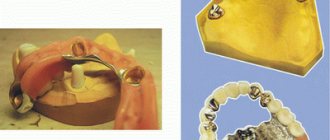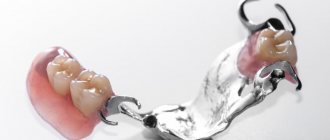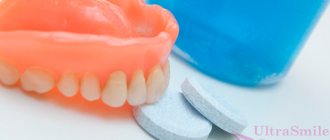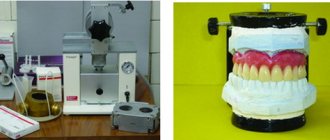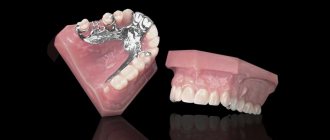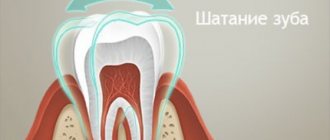Dental restorations are widely used to restore the aesthetics and function of teeth, but they require proper care to last as long as possible. Therefore, it is important to know how to store removable dentures and how to process them. Experts will give useful recommendations. If you do not do everything correctly, there may be negative consequences for the orthodontic products themselves, for other teeth and the entire oral cavity. The dentist usually gives advice on how to avoid problems, but some patients do not immediately follow them.
Caring for removable dentures
It must be carried out constantly at home in order for the results to be pleasing. It provides for the use of such devices and means:
- a soft toothbrush that cannot harm structures, weaken their fixation, or deform them. When using this hygiene item, you need to pay attention to the cleaning process. It is necessary to carefully treat areas of products in contact with the gums;
- toothpaste that does not contain abrasives. For example, you can use a baby product;
- solutions with disinfectant effects. These can be rinses with antiseptic ingredients, Chlorhexidine.
In addition to caring for orthodontic structures at home, regular professional cleaning should not be neglected. The specialist will carefully and thoroughly remove plaque and stone that forms on the teeth over time. This helps prevent the development of pathogenic organisms in the oral cavity.
What affects the wear of materials and elements
The artificial materials from which clasp dentures (and any others) are made cannot be independently renewed and restored, like natural fabrics. We are talking about the natural process of enamel remineralization (calcium saturation) or gum regeneration. Of course, you need to take care of your own teeth and gums, but also artificial ones. What many people forget about, believing that since such “teeth” cannot hurt, then there is no need to care for them. Therefore, some factors can lead to early wear of the orthopedic structure. Let's look at them in more detail:
- poor-quality care: irregular cleaning, an abundance of soft and sweet foods in the diet - combined with the lack of rinsing the mouth after such meals, refusal of professional cleaning 1-2 times a year in a clinic,
- too much force when cleaning: you can scratch the acrylic base or break the fasteners,
- incorrectly selected hygiene products: it can be either a very hard brush or a soft one - the first leaves scratches, the second cannot cope with plaque. Toothpaste with a large amount of abrasive particles also scratches the material, which reduces its service life. Dyes and pieces of food get clogged into microcracks - the material darkens, becomes dull, and may emit an unpleasant odor,
- exposure to harsh chemicals or extreme temperature changes,
- storage in an inappropriate place,
- eating very hard foods, chewing nut shells, etc.
Storage of removable dentures
The design of the products provides that they can and even need to be removed periodically. Consider a number of rules on how to do everything and where to store orthodontic structures:
- removal of contaminants. Before storing dentures, they must be cleaned of food debris, plaque, and microbes. To do this, use toothpaste, a brush and running water for rinsing;
- rubdown Speaking about how to properly store dentures, it should be noted that this is done if the structures are dry. Modern products are made from materials that cannot be left in a liquid environment for a long time;
- ensuring optimal humidity levels. It should be no more than 40–70%;
- protection from exposure to sunlight;
- protection from chemicals and vibrating devices. They can cause harm to structures (change their color, reduce their ability to securely fix, cause deformation).
Proper storage of dentures requires that a safe place be chosen. It is undesirable if children and pets have access to it, as they can harm themselves with the products or break them. Handling the orthodontic structure must be careful and careful. It should not be allowed to fall or have any object fall on it. It is necessary to provide protection from any mechanical impacts and shaking.
Currently, special containers are produced for storage. They are worth using because it is convenient and safe.
Your questions and answers
QUESTION Hello, is it possible to store a removable denture not in a special box, but in a kitchen container. New, of course. Tatiana P.
ANSWER Hello, Tatyana.
If it is not possible to purchase a special box for storing the prosthesis, then, in principle, a new container for products will do. Only a few conditions must be met. First, only the prosthesis in its pure form is stored here; there is no need to put food in the container. Secondly, you need to make holes for ventilation. Third, remove the container away from heat sources, household chemicals, and out of the reach of small children. Of course, it is better to purchase a special box that is designed specifically for prostheses, because... it is made from durable, certified material, and is also conveniently sized specifically for the prosthesis. 1Bark K., Burgoff W., Hede N. Diseases of the mucous membrane of the oral cavity and lips, 2021.
Removing dentures at night
Many patients wonder whether this should be done. Products that were previously used had to be removed before going to bed. With modern options this can not be done. If they get in the way, it’s more common for you to take them off at night, then no one forbids this. But you need to store them correctly (in accordance with the recommendations described above).
It should also be taken into account that after installing removable dentures, they should be worn without removing them for the first two weeks. This is necessary to quickly get used to them.
If wearing products causes discomfort, pain, sleep disturbances, or teeth grinding, then removing them at night is not the only solution to the problem. In such cases, you need to contact your dentist.
Which solutions are suitable for storage
Solutions - ready-made liquids or made from water and special cleaning tablets, are suitable only for caring for clasp dentures, but not for storage. Moreover, effervescent tablets are more popular, because take up less space and are more convenient to take with you. To clean the orthopedic structure, manufacturers suggest dissolving the tablet in a glass or container with clean water at room temperature. Then you should place the prosthesis in a container and leave it for 3 to 15 minutes (each brand has its own operating time). Then the “clasp” is removed, cleaned with a brush, washed in running water and dried. After these manipulations, you can install it on the jaw, but the solution must be poured out.
Popular brands of cleansing tablets are Corega, PresiDENT, Protefix, ROCS BONY plus Express, LACALUT DENT Reinigungs Tabs.
Consequences of improper storage of removable dentures
Storage errors can cause a number of problems:
- deformation of structures. This can happen due to overheating, prolonged exposure to a humid environment, or hypothermia;
- the appearance of detachments, microcracks, cracks, chips, pigmentation, growths, plaque where microbes develop;
- decreased ability for strong fixation. Caused by deformation processes, loss of integrity by parts of the structure.
No less dangerous consequences of improper storage of removable dentures are the destruction and loosening of adjacent teeth. Over time, this can lead to their loss.
Patient's note. Clasp prosthesis
What unusual sensations await you during the period of adaptation to a clasp denture?
Foreign body effect
This is exactly what your clasp prosthesis is for the body. These feelings are especially acute in the first week after receiving the prosthesis. All your attention may be focused on this feeling for a long time; it may interfere with your work and rest. In people with unstable nervous activity, who can hardly bear the slightest irritation, this feeling gives rise to the desire to remove the prosthesis and abandon it.
Do not do that! Try to be a little patient and every day it will get a little easier.
The effect of “novelty” and the effect of “presence”
You may feel like your denture is taking up all the space in your mouth. There is little room for the tongue, and the lips and cheeks are full and pushed back. You feel the volume and size of the prosthesis.
And this is all due to the design feature of the clasp prosthesis and the presence in it not only of teeth, but also of a metal arch, artificial gum and fixation elements. Such sensations will be new to you, and this is the norm.
Painful sensations in the teeth
It can be expressed in the form of clenching or unclenching of the teeth, pain when chewing and touching the teeth. This is due to the peculiarities of fixation of clasp dentures. And this kind of sensation in the teeth is a normal reaction to the increased chewing load on them. This will go away on its own as the teeth adapt.
Painful sensations in the gums
They will be especially noticeable during chewing and closing teeth. This is a distinctive feature of absolutely all removable structures, since they put pressure on the gums, which is not physiological.
In clasp dentures it is minimal, but still there. If these sensations occur throughout the entire length of the prosthesis, this is normal at first, and you will simply have to get used to it.
If the pain is localized at some point, you will need to come in for correction of the prosthesis. But, before coming, you must wear the prosthesis for at least 3 hours without removing it. During the examination, the doctor will be able to quickly determine the location of the rubbing and make a minimum number of corrections in the future (there may be 3-4).
Unusual sensations when closing teeth
Teeth in a clasp denture may appear “higher” and be slightly palpable when moving the jaw left and right and back and forth. This is because they have a completely new chewing surface that is different from your old teeth. It just takes time to get used to it.
Nausea and vomiting
This is due to the gag reflex, and the prosthesis is an irritant for it. It’s not a problem, just take any sucking lollipops, and these symptoms will disappear very quickly.
Impaired taste and tactile sensations in the mouth
At first, you may not feel the taste and temperature of food so clearly. This is not surprising, since the prosthesis covers part of the mucous membrane. The sensations will be restored, but it will take time.
Salivation disorders
This is expressed in its abundant discharge in the first 2 weeks, dry mouth in the next 2 weeks, and normalization a month after fixing the prosthesis. This is how the body reacts to a foreign body, and these phenomena are quite normal.
Speech Impairment
After fixing the prosthesis, the pronunciation of some words and sounds may be impaired. This is a consequence of restrictions on the movements of the tongue due to the presence of a prosthesis in the mouth. At the end of the adaptation period, everything will be restored. During this period, try to speak more, read aloud and practice pronouncing complex sounds and words.
Mobility of the prosthesis
It is a consequence of the design features of the clasp denture and the shock-absorbing properties of the gum itself. It is for this reason that these prostheses are classified as removable structures. To enhance fixation, you can use special creams (President, Corega, Protefix).
To do this, the denture is thoroughly cleaned, dried with tampons, and the cream itself is applied in broken lines. Afterwards the prosthesis is fixed in the mouth. This cream will also prevent food from getting under the denture.
Chewing and eating
It is with this process that many problems are associated at first, since the clasp denture is structurally very different from your natural teeth. And the sensations during chewing will also differ.
Removable dentures restore only 30-70% of chewing efficiency, with clasp dentures this figure is maximum and amounts to 70%, but you still won’t be able to chew with them as if you were using your own teeth.
In the first days, start with soft food and gradually increase its hardness by 3-4 weeks. It is recommended to eat slowly, in small pieces and not put a lot of food into your mouth at once. This will relieve you of pain in your gums.
Try not to bite with your front teeth at first, but chew food with your side teeth (simultaneously, left and right at once). This type of chewing is not entirely comfortable, but it will prevent the denture from tipping over and falling off. In the future, you will be able to chew on one side, while one of them will be more comfortable (this is your working side), and the second less (this is the auxiliary side). It will not be possible to feel the same comfort when chewing on both sides.
Never eat: very hard, hot or sticky foods.
Caring for clasp dentures
For the longest and most comfortable use of clasp dentures, we recommend that you follow certain hygiene rules, and the most important of them is that the denture must be clean.
This will preserve its attractive appearance for a long time, and will relieve you of unpleasant odor, inflammation and atrophy of the gums. Cleaning should be done regularly - twice a day (morning and evening), remove and clean the denture with toothpaste or soap and a toothbrush.
You can use cleaning tablets: dissolve 1 tablet (CoregaTabs) in 0.5 glasses of water, put the clasp denture in a glass for 15 minutes, and then rinse thoroughly under running water.
After each meal, the denture should be removed from the mouth and rinsed thoroughly with water. If this is not possible, then at least rinse your mouth with water. To prevent food from getting under the denture, use fixing creams (President, Corega, Protefix).
Clasp dentures do not need to be removed at night; they can also be left in place for up to 3 days, subject to proper hygiene rules (cleaning and rinsing).
If, for some reason, you remove the prosthesis for a long time, then you need to store it in a special sealed case or bag, after adding a little water there.
The prosthesis should not be stored dry!
Recommendations for the future
1. You need to visit an orthopedic dentist at least once a year to examine and check the integrity of the prosthetic structure.
2. Once a year, the denture needs to be relined and artificial gum added.
3. Once a year, it is possible to replace the silicone fixing locking elements (if they are included in the design).
4. Replacement of the clasp prosthesis is recommended after 5-6 years.
If you experience any unpleasant sensations, we are waiting for you to see an orthopedic doctor.
tel. 8(8452) 736-222, 65-00-51
Solutions for storing and caring for removable dentures
Previously, products with potassium permanganate and soda were used for these purposes. Today, this approach is a thing of the past, since these substances can cause harm.
Modern compositions are divided into:
- fixing (gel, cream, glue), thanks to which the structures fit tightly to the gums without falling off, including when eating. They also help prevent food from getting under the products. If it accumulates, it will become a medium for the development of microbes;
- Cleansers – products used as part of recommendations on how to properly store removable dentures at night.
The latter are represented by antiseptic compounds that are used to thoroughly clean structures from plaque, food debris, and pathogenic microorganisms. To do this, they should be soaked in the solution once a week for 5–15 minutes. Afterwards they are removed, washed, dried, and wiped with a napkin.
Such formulations are produced in the form of liquids and tablets that need to be diluted with water. Representatives of the former are Curaprox weekly, Orthosol-Dent. From the second category, the drugs Protefix and Corega are popular. But it is better to make the choice on the recommendation of a doctor.
Proper storage and care of removable dentures ensures their long service life. In addition, this is the key to the health of the entire oral cavity.
What features do “clasps” have?
Clasp orthopedic structures have several key features and differences from other “pullers” - a metal arch at the base, a small palatal bridge and several ways to attach the prosthesis to the teeth. Let's look at these features below.
Only until December 25 South Korean implant Osstem - from 18,500 rubles.
Hurry up to sign up for a free consultation and lock in promotional prices.
Call now or request a call
Opening hours: 24 hours a day - seven days a week
Presence of a metal arc
The clasp prosthesis differs from all other removable orthopedic structures in that it has a rigid metal frame - this is the clasp or arch. It runs along the entire base, i.e. both in areas hidden by artificial gum, and in areas “free” from the gingival base - usually along a group of preserved teeth. Allows high-quality distribution of chewing pressure compared to other removable ones, therefore it is more comfortable to wear and use - it does not rub and copes with chewing food.
Features of dentures for the upper jaw
Another difference is the presence of a metal palatal bridge (for upper jaw prosthetics). It is also made of metal, but this structural element is not as massive as, for example, a plate prosthesis. In a clasp, the palatal bridge looks like a thin bridge or ring (there may be several options here), but in any case it takes up little space in the oral cavity.
Attaching the clasp structure to the teeth
Next, you need to dwell on the fastening elements of the clasp prosthesis; it can be of the following varieties - hooks (clasps), locks1 (attachments), telescopic crowns. Retainers are usually made of metal. But, for example, attachments can be partially “hidden” in the crowns or base of the prosthesis. To improve aesthetics, the upper parts of telescopic crowns are covered with light materials - ceramics, composite and others.
How to whiten a nylon denture
The service life of a nylon prosthesis depends on care and gentle use. Daily brushing and rinsing with solutions will help prevent plaque from appearing. For severe contamination, use tablets. Regardless of the condition of the teeth, ultrasonic cleaning is carried out in the dentist’s office every six months. The doctor will tell you how to whiten a nylon denture without damaging the structure of the artificial teeth.
It is recommended to get rid of smoking and other habits that “color” the material. For whitening, special brushes are used, and instead of a paste, a solution based on tablets is used. Tablet preparations remove plaque, whiten, and remove bacteria. It is better to select a product together with a specialist.
Doctors recommend using products from one manufacturer. So tablets, a brush, cleansing gel or toothpaste from one company will have a prolonged whitening effect. It is not advisable to use aspirin, soda, lemon juice and other traditional methods for whitening; the risk of damaging teeth increases significantly.
A nylon product can retain its attractive appearance and functionality for years. Professional cleaning of teeth (dentures), regular examination by a specialist, properly selected care and careful use are the key to long service life of dentures. When using any cleaning products, it is better to follow the instructions.

